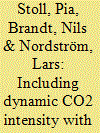| Srl | Item |
| 1 |
ID:
127269


|
|
|
|
|
| Publication |
2014.
|
| Summary/Abstract |
Hourly demand response tariffs with the intention of reducing or shifting loads during peak demand hours are being intensively discussed among policy-makers, researchers and executives of future electricity systems. Demand response rates have still low customer acceptance, apparently because the consumption habits requires stronger incentive to change than any proposed financial incentive. An hourly CO2 intensity signal could give customers an extra environmental motivation to shift or reduce loads during peak hours, as it would enable co-optimisation of electricity consumption costs and carbon emissions reductions. In this study, we calculated the hourly dynamic CO2 signal and applied the calculation to hourly electricity market data in Great Britain, Ontario and Sweden. This provided a novel understanding of the relationships between hourly electricity generation mix composition, electricity price and electricity mix CO2 intensity. Load shifts from high-price hours resulted in carbon emission reductions for electricity generation mixes where price and CO2 intensity were positively correlated. The reduction can be further improved if the shift is optimised using both price and CO2 intensity. The analysis also indicated that an hourly CO2 intensity signal can help avoid carbon emissions increases for mixes with a negative correlation between electricity price and CO2 Intensity.
|
|
|
|
|
|
|
|
|
|
|
|
|
|
|
|
| 2 |
ID:
125460


|
|
|
|
|
| Publication |
2013.
|
| Summary/Abstract |
The purpose of this paper is to explore to what extent the integrated infrastructural system in Hammarby Sjöstad, Stockholm, also named the Hammarby Model, reduces the metabolic flows of the district, and to what extent the district is self-sufficient, in terms of generated energy. Furthermore, the paper aspires to help create a deeper understanding of the system in order to guide the implementation of similar models in other districts, creating more sustainable cities. The method has been to quantify the local mass and energy flows of the model, using the secondary energy generated within Hammarby Sjöstad as basis when creating the system boundaries of the calculations. The findings demonstrate that the Hammarby Model reduces the metabolic flows of Hammarby Sjöstad but that the district is far from self-sufficient in terms of secondary energy. The conclusions of the paper are that the development of integrated infrastructural systems is one way to help create more sustainable cities. However, in order to reduce metabolic flows even further, the efficiency of the system must be improved by integrating more renewable energy sources. At the same time less energy has to be used in the households.
|
|
|
|
|
|
|
|
|
|
|
|
|
|
|
|